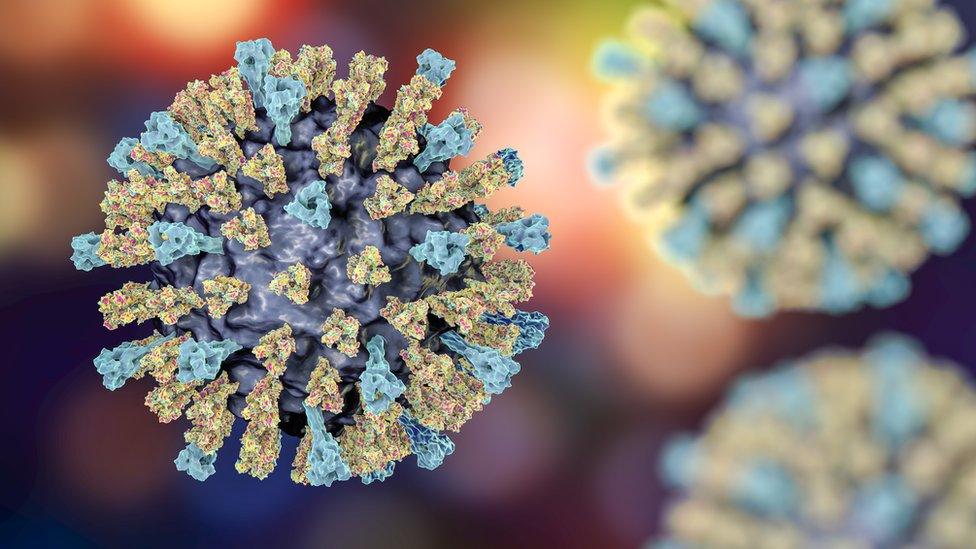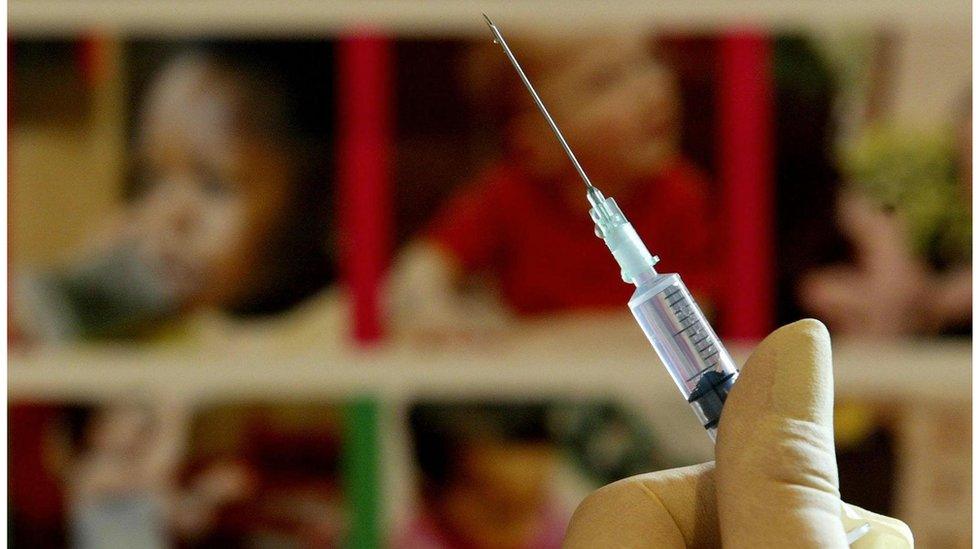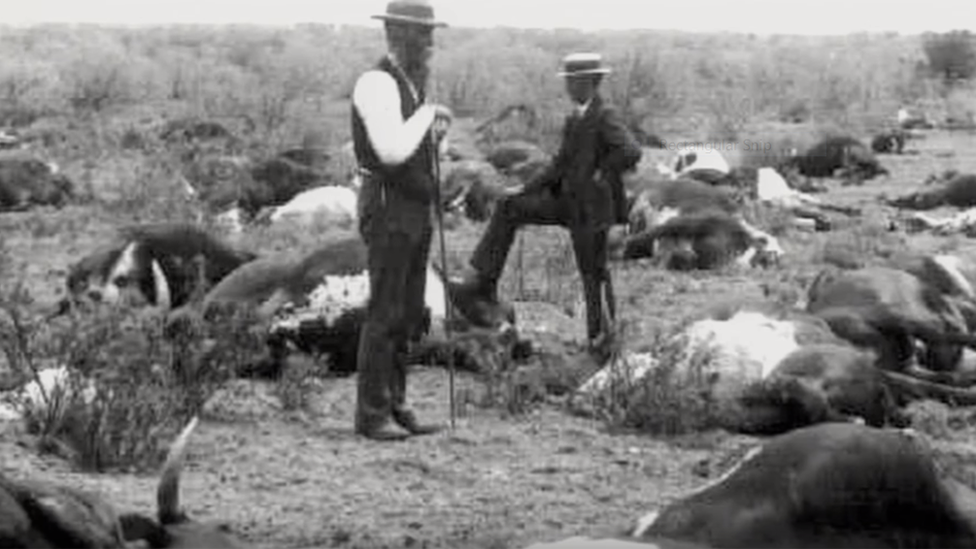Could relatives of measles virus jump from animals to us?
- Published

Artwork: Measles is one member of an extended family of viruses
We've seen recent spikes in measles infections.
Some European countries, including the UK, lost their measles-free status and many developing countries, especially parts of Africa, Asia and Oceania are seeing frequent outbreaks.
The Democratic Republic of the Congo (DRC) is experiencing a protracted outbreak of over a quarter of a million cases and more than 5,000 deaths, mainly in children under-five.
And the reason for this measles upturn?
Declining uptake of measles vaccination. You need to immunise over 90% of a population to protect it from measles outbreaks. In DRC immunisation rates are less than 60%.
Killer virus destroyed by UK lab
And there's a potential hidden danger of poor vaccine coverage.
Measles belongs to a group of highly related viruses called morbilliviruses, which can be found in various mammals, and these are adept at jumping from one host species to another.
The common ancestor of measles virus is thought to have been a virus circulating in cattle which, according to Louise Cosby, emeritus, honorary professor at the Wellcome Wolfson Institute for Experimental Medicine, "probably jumped into humans when cattle were domesticated thousands of years ago".
"There are also historical records which suggest that canine distemper virus - or CDV - might have arisen from human measles in the Americas, following one or more human-to-dog spill-overs during extensive measles outbreaks in indigenous people, who were exposed to the virus for the first time when they came into contact with European explorers," she explained.
A cross-species spill-over is the transmission of a pathogen from one vertebrate species to another.

There might be another potential hidden danger of poor vaccine coverage
Deadly to dogs
As CDV has spread around the world, there are many examples of it hopping into other species including seals, cats and even monkeys - often with devastating effects.
In the 1980s, this virus wiped out the last wild population of black-footed ferrets and is even putting some endangered big cat species in peril.
To be able to flit from one species to another, a virus often has to adapt in order to use the new host cell machinery.
We call these potential host-blocks to virus infection the species barrier.
The first barrier a virus must overcome is cell attachment and entry. According to Dr Dalan Bailey, a virologist based at the Pirbright Institute, what makes morbilliviruses so adept at cross-species transmission is that the proteins it commandeers to do this are very similar across different mammalian species, so the species barrier is low.
And this could pose a potential future risk to human health
"We've definitely got evidence that non-human morbilliviruses can easily adapt to enter human cells, and we're confident that it can replicate in them too," Dr Bailey said.
It takes just two simple mutations in one of CDV's surface proteins to allow it to infect human cells.
A threat to humans
So, what's stopping animal morbilliviruses cropping up in humans?
"A major factor is likely to be pre-existing immunity, where natural infection or vaccination against measles provides a pool of antibodies, some of which cross-react and prevent infection by non-human morbilliviruses", explained Dr Bailey.
But, as vaccination rates fall, we will continue to see major outbreaks of measles, and this will give other morbilliviruses, like CDV, the chance to explore a new human host.
Currently, there is no evidence of human infection by CDV or any of its close non-human virus relatives, but we cannot discount the possibility, as Dr Katrina Lythgoe, from the Big Data Institute at the University of Oxford explained.
"You might have a sub-population of individuals where there's been no recent measles outbreaks and low vaccination coverage, and therefore low measles immunity. And it's in these people where you might see possible localised outbreaks," she said.
"We know spill-overs can happen - measles was one after all - but whether we could get human-to-human chains of transmission is difficult to say."
Often a virus must mutate for successful cross-species transmission. And whilst declining vaccination rates might not provide enough scope for a non-human morbillivirus to adapt and outcompete measles, there is one scenario where emergence might just be possible - The World Health Organization'sWHO plans for measles eradication., external
Inside the lab where they study the world's most deadly diseases
If we successfully eradicate measles through vaccination, there will be a temptation to stop immunisation, and herd immunity to measles - and therefore other morbilliviruses - will decline.
Prof Brian Willett, who studies morbilliviruses at the University of Glasgow agrees that it's this scenario, rather than falling vaccination rates, that could provide CDV with the opportunity to infect humans. But only if the conditions are right.
"Will it start in the UK? Well no, because most dogs are vaccinated and there's very little CDV. It would have to be in a country where dogs or other animals can develop CDV, for example in the US where there are outbreaks in raccoons, skunks and grey foxes which could spread into local dog populations," Prof Willett explained.
"A lot of things would have to fall into place. Removing measles immunity from the human population, an animal population that is shedding CDV and then the two coming together.
"So, if you remove measles immunity from a country where morbilliviruses such as CDV are endemic, then it's only a matter of time before you start to see evidence of humans being exposed. Whether the virus would then adapt to the new host remains to be seen", he said
Bovine clues
The researchers that I have spoken to are quick to highlight what happened in cattle when rinderpest vaccination stopped following its eradication.
"The net effect of rinderpest eradication was that there was no herd immunity to morbillivirus in cattle worldwide," said Dr Bailey.
"And what we are seeing now in the field is compelling evidence of infection by a morbillivirus called PPRV".
PPRV - or Peste des Petits Ruminants virus to give it its full name - circulates widely in relatively small animals such as sheep and goats.

Rinderpest devastated cattle in Africa during the 1890s. Millions of people died from starvation.
The amount of infection that cattle are now experiencing is immense. "In Pakistan they're seeing seroprevalence of up to 17%, in Sudan they've seen 42% and I've spoken to people working in Tanzania and from the DRC and they're all seeing this high seropositivity," said Dr Bailey.
In sheep, goats and even antelope, PPRV can be devastating. So far there is no evidence that it causes any disease in cattle.
There's one obvious lesson from rinderpest eradication - that declining measles immunity will mean humans are susceptible to other morbilliviruses.
Of course, we can't predict which, or even if, a virus would emerge. But reported infections in monkeys makes CDV a prime candidate.
How it might behave if it does make the switch to humans is difficult to predict.
"Although measles infection can have devastating complications, this is rarer compared to CDV and some of the other morbilliviruses which normally produce severe disease in their natural hosts," said Prof Cosby.
"CDV is very virulent and normally will infect the brain in the later stages of the disease, whereas with measles this is a rare, but really dangerous event."
"This is not the only cause of death, as all morbilliviruses, including CDV, cause immune suppression in their host, which can lead to secondary bacterial infections, giving rise particularly to pneumonia and in some cases diarrhoea. So, CDV is a pretty nasty disease," she said.
Monkey deaths
Prof Cosby added: "Compared to measles, when you look at how CDV and the other morbilliviruses behave in the host, they're really devastating."
We can't tell what CDV would do to humans, but the fact that in some of the monkey outbreaks, many of the animals died should give us some cause for concern.
If we do ever reach the point of having a measles-free world, then we'll have to think very carefully about how best to stop its relatives hopping on board.
Some think that continued use of the measles vaccine might be sufficient to protect against a possible jump into humans by CDV, but Prof Cosby isn't as convinced:
"Although measles antibodies cross-react with CDV, they're not a perfect match; whilst measles vaccine helps to protect against CDV disease in non-human primates it does not totally stop virus being released from these animals.
"So, we may need to use a more CDV-specific vaccine to prevent any potential spread of CDV in the human population".
Of course, the most pressing consideration is not what might happen if we do eradicate measles, but how we can rise to the challenge of making this happen.
It will require better global access to the measles vaccine and many more people willing to take it.
Until then, measles will hang on to its deadly human morbillivirus billing.